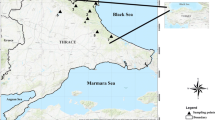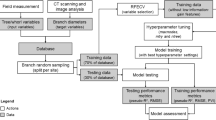Abstract
This work focuses on the development of dendrometric algorithms to calculate the volume and total biomass contained in olive trees. This laid the foundation for the use of this methodology as a tool to manage resources from orchards, establishing adequate prediction models for assessing other parameters such as income from raw materials from the cultivation, fruit production, CO2 sinks, and waste materials (residual wood) used for energy or industry. Dendrometry has traditionally been applied to forest trees. However, little research has been conducted on fruit trees because of their heterogeneous structure. This issue was the first step of this research. For this, the form factors were calculated. This relates to the actual volume of the branch with a model volume, calculated as a revolution solid from the base diameter and length. The shape more approximated to 1 was the cylinder model with a mean value of 0.76 and standard deviation (SD) of 0.23. On the other hand, volume equations were obtained for the branches. The distribution of biomass in the tree was analyzed. It is estimated that 40 % of biomass is located in the stem and 60 % in the crown, and most of the crown biomass is concentrated in the first branches (60 %). Afterwards, occupation factors were calculated to relate the wood volume in the crown to its apparent volume, the mean being 0.005 dm3/m3 and SD 0.0025 dm3/m3. Also, equations for predicting the whole wood in the crown were obtained. In this regard, the best results were obtained when the crown diameter was used (R 2 = 0.74). These results could be correlated with the production and quality of the fruit, amount of residual biomass coming from pruning, and LIDAR data, which may indicate a simple, quick, and accurate method for predicting biomass.





Similar content being viewed by others
References
Callejón-Ferre A, Velazquez-Marti B, Lopez-Martinez J, Manzano-Agugliaro F (2011) Greenhouse crop residues: energy potential and models for the prediction of their higher heating value. Renew Sustain Energy Rev 15(2):948–955
CAPA (2010) Informe del sector agrario valenciano 2010. http://www.agricultura.gva.es/documents/170659/179161/ISAV-2010_N.pdf/f0128d9b-3de3-43d7-a3f2-5bcdac0cf10d
Cara C, Ruiz E, Ballesteros M, Manzanares P, Negro MJ (2008) Production of fuel ethanol from steam-explosion pretreated olive tree pruning. Fuel 87(6):692–700
Dieguez U, Barrio M, Castedo F, Alvarez MF, Ruiz AD, Álvarez JG, Rojo A (2003) Dendrometry. Mundi-Prensa, Madrid
Estornell J, Ruiz L, Velazquez-Marti B (2011) Study of shrub cover and height using LIDAR data in a Mediterranean area. For Sci 57(3):171–179
Fernández González E (2010) Análisis de los procesos de producción de biomasa residual procedente del cultivo de frutales mediterráneos. Cuantificación, cosecha y caracterización para su uso energético o industrial. Ph.D. Thesis, Universidad Politécnica de Valencia, pp 376
Maltamo M, Eerikäinen K, Pitkänen J, Hyyppä J, Vehmas M (2004) Estimation of timber volume and stem density based on scanning laser altimetry and expected tree size distribution functions. Remote Sens Environ 90:319–330
Naslund M (1940) Funktioiner och tabeller for kubering av staende trad. Tall, gran och bjork I norra Sverige, vol 32. Maddelanden Fran Statens Skogsforskningsinstitut, Stockholm, pp 87–142
Persson A, Holmgren J, Söderman U (2002) Detecting and measuring individual trees using an airborne laser scanner. Photogramm Eng Remote Sens 68:925–932
Popescu SC (2007) Estimating biomass of individual pine trees using airborne LIDAR. Biomass Bioenergy 31:646–655
Requejo A, Peleteiro S, Garrote G, Rodriguez A, Jimenez L (2012) Biorefinery of olive pruning using various processes. Bioresour Technol 111:301–307
Romero I, Moya M, Sanchez S, Ruiz E, Castro E (2007) Ethanolic fermentation of phosphoric acid hydrolysates from olive tree pruning. Ind Crops Prod 25(2):160–168
Rosua JM, Pasadas M (2012) Biomass potential in Andalusia, from grapevines, olives, fruit trees and poplar, for providing heating in homes. Renew Sustain Energy Rev 16(6):4190–4195
Spurr SH (1952) Forest inventory. The Ronald Press Company, New York
Toledano A, Serrano L, Labidi J (2012) Process for olive tree pruning lignin revalorisation. Chem Eng J 193–194:396–403
Velázquez-Martí B (2006) Aprovechamiento de los residuos forestales para uso energético. Ed UPV. ISBN: 97-8848-363049-5. Ed. UPV. Ref. 2006.799
Velázquez-Martí B, Annevelink E (2009) GIS application to define biomass collection points as sources for linear programming of delivery networks. Trans ASABE 52(4):1069–1078
Velázquez-Martí B, Fernández-González E (2009) Analysis of the process of biomass harvesting with collecting-chippers fed by pick up headers in plantations of olive trees. Biosyst Eng 52(4):225–236
Velázquez-Martí B, Fernandez-Gonzalez E, Estornell J, Ruiz LA (2010) Dendrometric and dasometric analysis of the bushy biomass in Mediterranean forests. For Ecol Manag 259:875–882
Velázquez-Martí B, Fernández-González E, López-Cortes I, Salazar-Hernández DM (2011a) Quantification of the residual biomass obtained from pruning of trees in Mediterranean olive groves. Biomass Bioenergy 35:3208–3217
Velázquez Martí B, Fernández González E, López Cortés I, Salazar Hernández DM (2011b) Quantification of the residual biomass obtained from pruning of trees in Mediterranean almond groves. Renew Energy 36(2):621–626
Velázquez-Martí B, Estornell J, López-Cortés I, Martí-Gavila J (2012) Calculation of biomass volume of citrus trees from an adapted dendrometry. Biosyst Eng 112(4):285–292
Acknowledgments
We are grateful to the Spanish Ministry of Science and Innovation for funding this research by means of the National Program of R+D project: AGL2010-15334.
Author information
Authors and Affiliations
Corresponding author
Rights and permissions
About this article
Cite this article
Velázquez-Martí, B., López Cortés, I. & Salazar-Hernández, D.M. Dendrometric analysis of olive trees for wood biomass quantification in Mediterranean orchards. Agroforest Syst 88, 755–765 (2014). https://doi.org/10.1007/s10457-014-9718-1
Received:
Accepted:
Published:
Issue Date:
DOI: https://doi.org/10.1007/s10457-014-9718-1




